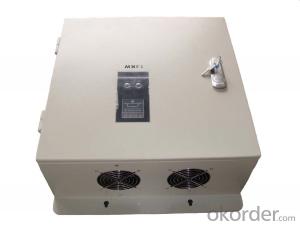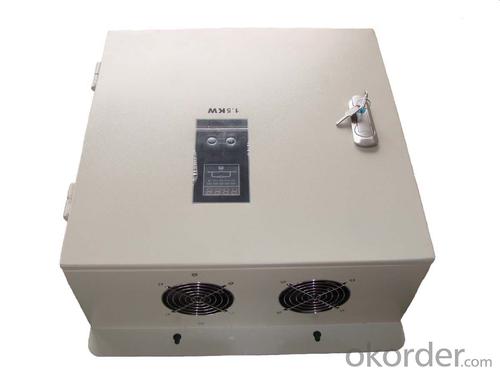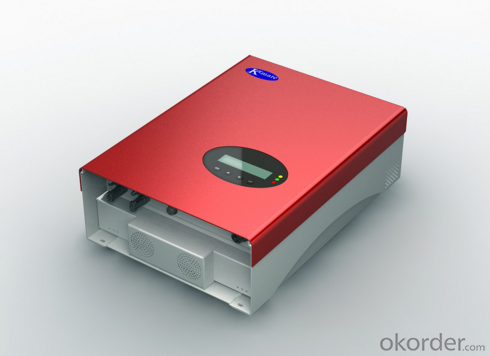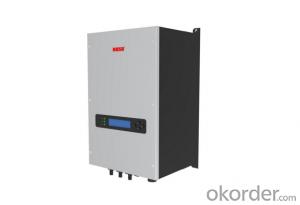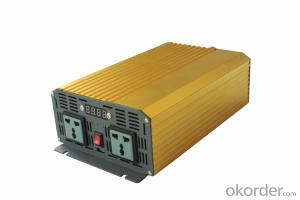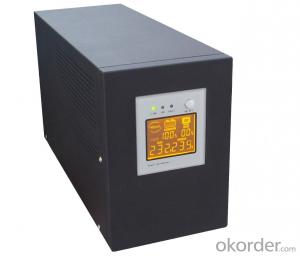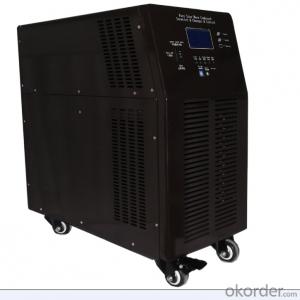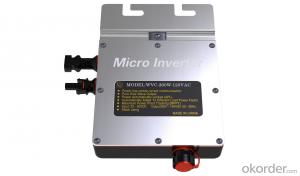Invt Solar Inverter - Single Phase 1kW Inverter Made in China
- Loading Port:
- Shanghai
- Payment Terms:
- TT OR LC
- Min Order Qty:
- 0 watt
- Supply Capability:
- 10000 watt/month
OKorder Service Pledge
OKorder Financial Service
You Might Also Like
Description of Single Phase1K Inverter
Single Phase1K Inverter made in China
Features of Single Phase1K Inverter
High MPPT accuracy(>99.9%)
Wide DC input range (60~300 Vdc), compatible with different module
Easy to wire, install and operate
IP65 design, suitable for indoor and outdoor installation
10 years warranty(5~25 years optional)
Technical Data of Single Phase1K Inverter
| Type | Omniksol-1k-TL-M |
| Input(DC) | |
| Max.PV Power | 1.25kW |
| Max,DC Voltage | 400V |
| Operating MPPT Voltage Range | 60-300V |
| MPPT Voltage Range at Nominal Power | 100-300V |
| Start up DC Voltage | 70V |
| Turn off DC Voltage | 50V |
| Max, DC Current | 10A |
| Max, Short Cicuit Current for each MPPT | 12A |
| Number of MPP trackers | 1 |
| Number of DC Connection for each MPPT | 1 |
| DC Connection Type | MC4 connector |
| Output(AC) | |
| Max,AC Apparent Power | 1000VA |
| Nominal AC Power (cos phi = 1) | 1000W |
| Nominal Grid Voltage | 220V/230V/240V |
| Nominal Grid Frequency | 50Hz/60Hz |
| Max, AC Current | 5.0A |
| Grid Voltage Range** | 185-276V |
| Grid Frequency Range** | 45-55Hz/55-65Hz |
| Power Factor | >0.99 |
| Total Harmonic Distortion(THD) | <3% |
| Feed in Starting Power | 30W |
| Night time Power Consumption | <1W |
| Standby Consumption | 6W |
| AC Connection Type | Plug-in connertor |
| Efficiency | |
| Max,Efficiency | 95.5% |
| Euro Efficiency | 94.2% |
| MPPT Efficiency | 99.9% |
| Safety and Protection | |
| DC Insulation Monitoring | Yes |
| DC Switch | Optional |
| Residual Current Monitoring Unit (RCMU) | Integrated |
| Grid Monitoring with Anti-islanding | Yes |
| Protection Class | Ⅰ(According to IEC 62103) |
| Overvoltage Category | PV Ⅱ/ Mains Ⅲ(According to IEC 62109-1) |
| Reference Standard | |
| Safety Standard | EN 62109, AS/NZS 3100 |
| EMC Standard | EN 6100-6-1, EN 6100-6-2, EN 6100-6-3 EN 6100-6-4, EN 6100-3-2, EN 6100-3-3 |
| Grid Standard | VDE-AR-N4105. VDE-0126-1-1,G83/1,EN 50438,RD1699,CEI 0-21, AS4777,C10/C11 |
| Physical Structure | |
| Dimensions | 210x297x90mm |
| Weight | 5.5kg |
| Environmental Protection Rating | IP 65 (According to IEC 60529) |
| Cooling Concept | Natural convection |
| Mounting Information | Wall bracket |
| General Data | |
| Operating Temperature Range | -25℃ to +60℃(derating above 45℃) |
| Relative Humidity | 0% to 98%, no condensation |
| Max. Altitude (above sea level) | 2000m |
| Noise Type | <45dB |
| Isolation Type | Transformerless |
| Display | 2LED Backlight 16*2 Character LCD |
| Data Communication | RS485(WiFi, GRPS optional) |
| Computer Communication | RS232 as option |
| Standard Warranty | 10 Years (5-25 years optional) |
IMages of Single Phase1K Inverter

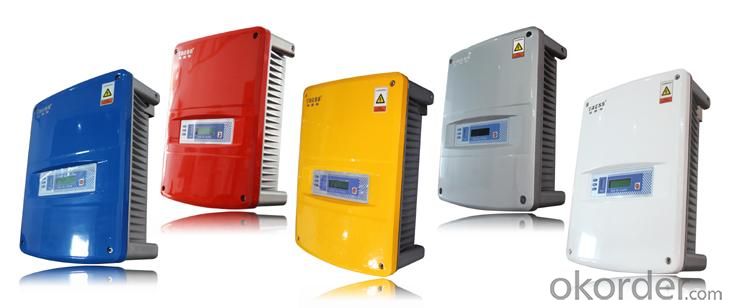
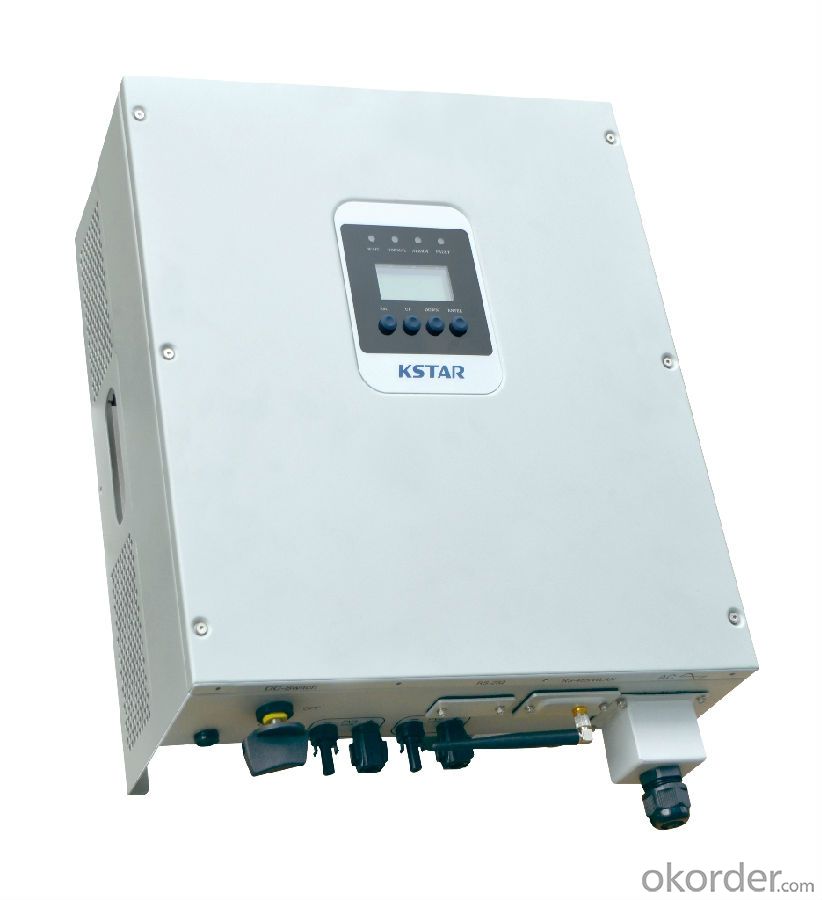
FAQ
Q: Do you have the CE, TUV, UL Certification?
A: We’ve already passed all the tests, and any certificate is available.
Q: Have you ever sold your products to companies in my country?
A: Of course, we have customers in all general PV markets, but I think we should expand our market share along with the market growth.
Q: When did your company set up? You are a new company, how can I believe your quality?
A: We entered into Solar PV industry in 2005, now we have several plants in manufacturing of a-Si and c-Si panels, and our capacity is 220MW per year. Till now we have already passed all the tests by authorized laboratories, e.g. TUV, CE, UL.
Q: Can you help us install the module if we cooperate with you?
A: We haven’t entered into installation sector, but we have the plan in near future.
Q: How do you pack your products?
A: We have rich experience on how to pack the panels to make sure the safety on shipment when it arrives at the destination.
Q: Can you do OEM for us?
A: Yes, we can.
Q: Can we visit your factory?
A: Surely, I will arrange the trip basing on your business schedule.
- Q: How do you connect a solar inverter to a data monitoring system?
- To connect a solar inverter to a data monitoring system, you need to follow a few steps. First, ensure that your solar inverter is compatible with a data monitoring system. Next, connect the inverter to a local network, either wired or wireless, depending on the available options. Then, configure the inverter's settings to enable data transmission. Finally, install the required software or app provided by the data monitoring system and use the provided instructions to link the inverter to the monitoring system.
- Q: How do you calculate the power output of a solar inverter?
- The power output of a solar inverter can be calculated by multiplying the DC voltage input from the solar panels by the DC current output. This will give you the DC power output. To calculate the AC power output, you need to consider the efficiency of the inverter. Multiply the DC power output by the inverter efficiency to determine the AC power output.
- Q: What is the role of reactive power injection in a solar inverter?
- The role of reactive power injection in a solar inverter is to improve power factor and stabilize the voltage in the electrical grid. By injecting reactive power, the inverter helps balance out the reactive power demand from other loads in the grid, reducing the strain on the system and ensuring efficient power transfer. This helps maintain grid stability and prevents voltage fluctuations, ultimately enhancing the overall performance and reliability of the solar power system.
- Q: How does a solar inverter handle frequency variations in the grid?
- A solar inverter handles frequency variations in the grid by continuously monitoring the frequency and adjusting its own output accordingly. When the grid frequency increases, the inverter reduces its output frequency to match, and vice versa. This helps maintain a stable and synchronized connection to the grid, ensuring efficient power transfer and protecting both the inverter and the grid from potential damage or instability.
- Q: Can a solar inverter be used with a solar-powered security camera system?
- Yes, a solar inverter can be used with a solar-powered security camera system. The solar inverter converts the DC (direct current) power generated by the solar panels into AC (alternating current) power, which can be used to power the security camera system. This setup allows for continuous and uninterrupted power supply to the security cameras, making them fully operational and independent of the electrical grid.
- Q: How does a solar inverter handle islanding detection and prevention?
- A solar inverter handles islanding detection and prevention by continuously monitoring the electrical grid's stability. It utilizes anti-islanding protection mechanisms to detect any abnormal conditions, such as voltage fluctuations or frequency deviations, that may indicate the presence of an islanded grid. In the event of islanding, the inverter immediately disconnects from the grid to prevent energy feed-in and effectively isolate the solar system. This ensures the safety of utility workers, prevents damage to equipment, and helps maintain the stability of the overall electrical grid.
- Q: What is the role of a DC-DC converter in a solar inverter?
- The role of a DC-DC converter in a solar inverter is to convert the direct current (DC) power produced by the solar panels into the appropriate voltage and current levels required to feed into the alternating current (AC) grid. This conversion ensures efficient power transfer from the solar panels to the electrical grid, enabling the solar energy to be used for various applications or to be stored in batteries.
- Q: What is the role of a power limiter in a solar inverter?
- The role of a power limiter in a solar inverter is to regulate and limit the amount of power that can be generated and fed back into the electrical grid. It ensures that the solar system does not exceed the permitted power limits set by the utility company or regulatory authorities, preventing any potential damage to the grid infrastructure. Additionally, a power limiter helps maintain a stable and reliable power supply by controlling the amount of solar energy that is being exported or utilized within a specific threshold.
- Q: Can a solar inverter be used in parallel configurations for increased power output?
- Yes, a solar inverter can be used in parallel configurations to increase power output. By connecting multiple inverters in parallel, the total power output can be increased, allowing for more efficient utilization of solar energy.
- Q: How do you calculate the total power capacity for a solar inverter?
- To calculate the total power capacity for a solar inverter, you need to consider two main factors: the maximum power output of the solar panels and the efficiency of the inverter. First, determine the maximum power output of the solar panels in watts. Then, divide this value by the efficiency of the inverter, usually given as a percentage. The resulting value will give you the total power capacity of the solar inverter in watts.
Send your message to us
Invt Solar Inverter - Single Phase 1kW Inverter Made in China
- Loading Port:
- Shanghai
- Payment Terms:
- TT OR LC
- Min Order Qty:
- 0 watt
- Supply Capability:
- 10000 watt/month
OKorder Service Pledge
OKorder Financial Service
Similar products
Hot products
Hot Searches
Related keywords
